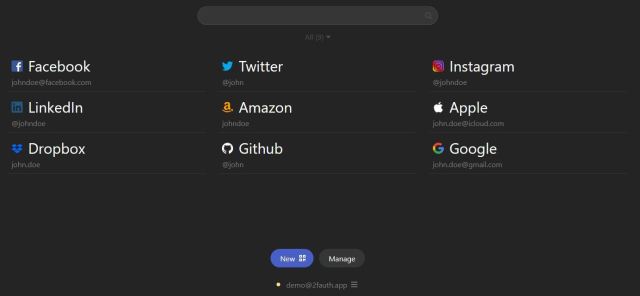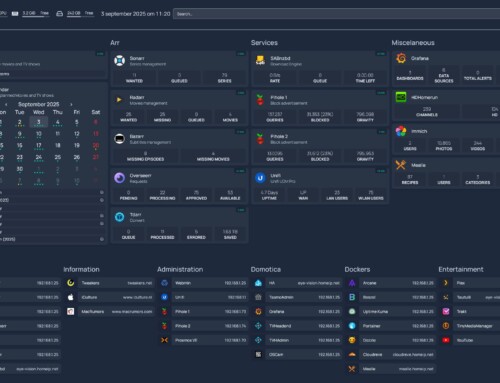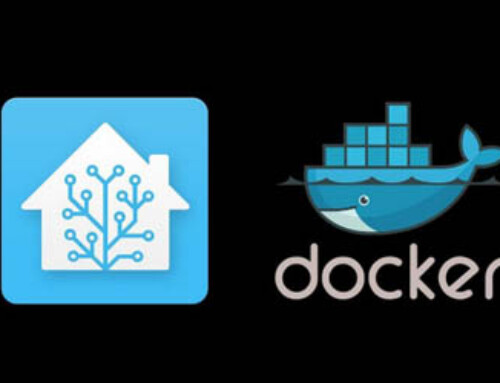2FAuth is een web-gebaseerd, zelfgehost alternatief voor One Time Passcode (OTP)-generatoren zoals Google Authenticator, ontworpen voor zowel mobiele apparaten als desktops.
Tweefactorauthenticatie is de laatste jaren erg populair geworden, waardoor we steeds vaker te maken krijgen met een verzoek om een beveiligingscode en het aantal accounts dat door deze technologie wordt beschermd, toeneemt. Met andere woorden, 2FA is nu onvermijdelijk en van cruciaal belang.
Het doel van 2FAuth is om het gebruik en beheer van je 2FA te vereenvoudigen met een overzichtelijke en geschikte interface, ongeacht het apparaat dat je gebruikt. Zit je achter je computer zonder je smartphone en krijg je een codeverzoek? Geen probleem, open gewoon deze 2FAuth web-applicatie in een browsertabblad en je hebt toegang tot je codes.
Bovendien kunt je als open source en zelfgehoste applicatie weer controle krijgen over je persoonlijke beveiligingsgegevens. Tevens heb je zo de mogelijkheid om een back-up te maken. Handig als je je smartphone (waar je dan toevallig geen backup van hebt) bent kwijtgeraakt met al je 2FA-accounts in Google Authenticator.
Het programma is erg eenvoudig m.b.v. een docker container te installeren. Creëer een ‘docker-compose.yml’ file met de volgende inhoud:
services:
2fauth:
image: 2fauth/2fauth
container_name: 2fauth
volumes:
- ./2fauth:/2fauth
ports:
- 8502:8000/tcp
restart: unless-stopped
environment:
# You can change the name of the app
- APP_NAME=2FAuth
# You can leave this on "local". If you change it to production most console commands will ask for extra confirmation.
# Never set it to "testing".
- APP_ENV=local
# The timezone for your application, which is used to record dates and times to database. This global setting can be
# overridden by users via in-app settings for a personalised dates and times display.
# If this setting is changed while the application is already running, existing records in the database won't be updated
- APP_TIMEZONE=UTC
# Set to true if you want to see debug information in error screens.
- APP_DEBUG=false
# This should be your email address
- SITE_OWNER=mail@example.com
# The encryption key for our database and sessions. Keep this very secure.
# If you generate a new one all existing data must be considered LOST.
# Change it to a string of exactly 32 chars or use command `php artisan key:generate` to generate it
- APP_KEY=SomeRandomStringOf32CharsExactly
# This variable must match your installation's external address.
# Webauthn won't work otherwise.
- APP_URL=http://localhost
# If you want to serve js assets from a CDN (like https://cdn.example.com),
# uncomment the following line and set this var with the CDN url.
# Otherwise, let this line commented.
# - ASSET_URL=http://localhost
#
# Turn this to true if you want your app to react like a demo.
# The Demo mode reset the app content every hours and set a generic demo user.
- IS_DEMO_APP=false
# The log channel defines where your log entries go to.
# 'daily' is the default logging mode giving you 7 daily rotated log files in /storage/logs/.
# Also available are 'errorlog', 'syslog', 'stderr', 'papertrail', 'slack' and a 'stack' channel
# to combine multiple channels into a single one.
- LOG_CHANNEL=daily
# Log level. You can set this from least severe to most severe:
# debug, info, notice, warning, error, critical, alert, emergency
# If you set it to debug your logs will grow large, and fast. If you set it to emergency probably
# nothing will get logged, ever.
- LOG_LEVEL=notice
# Database config (can only be sqlite)
- DB_DATABASE="/srv/database/database.sqlite"
# If you're looking for performance improvements, you could install memcached.
- CACHE_DRIVER=file
- SESSION_DRIVER=file
# Mail settings
# Refer your email provider documentation to configure your mail settings
# Set a value for every available setting to avoid issue
- MAIL_MAILER=smtp
- MAIL_HOST=smtp.mailtrap.io
- MAIL_PORT=465
- MAIL_ENCRYPTION=tls
- MAIL_USERNAME=john.doe@something.nl
- MAIL_PASSWORD=my_secret_password
- MAIL_FROM_NAME=2FAuth
- MAIL_FROM_ADDRESS=2fauth@mydomain.nl
# SSL peer verification.
# Set this to false to disable the SSL certificate validation.
# WARNING
# Disabling peer verification can result in a major security flaw.
# Change it only if you know what you're doing.
- MAIL_VERIFY_SSL_PEER=true
# API settings
# The maximum number of API calls in a minute from the same IP.
# Once reached, all requests from this IP will be rejected until the minute has elapsed.
# Set to null to disable the API throttling.
- THROTTLE_API=60
# Authentication settings
# The number of times per minute a user can fail to log in before being locked out.
# Once reached, all login attempts will be rejected until the minute has elapsed.
# This setting applies to both email/password and webauthn login attemps.
- LOGIN_THROTTLE=5
# The default authentication guard
# Supported:
# 'web-guard' : The Laravel built-in auth system (default if nulled)
# 'reverse-proxy-guard' : When 2FAuth is deployed behind a reverse-proxy that handle authentication
# WARNING
# When using 'reverse-proxy-guard' 2FAuth only look for the dedicated headers and skip all other built-in
# authentication checks. That means your proxy is fully responsible of the authentication process, 2FAuth will
# trust him as long as headers are presents.
- AUTHENTICATION_GUARD=web-guard
# Authentication log retention time, in days.
# Log entries older than that are automatically deleted.
- AUTHENTICATION_LOG_RETENTION=365
# Name of the HTTP headers sent by the reverse proxy that identifies the authenticated user at proxy level.
# Check your proxy documentation to find out how these headers are named (i.e 'REMOTE_USER', 'REMOTE_EMAIL', etc...)
# (only relevant when AUTHENTICATION_GUARD is set to 'reverse-proxy-guard')
- AUTH_PROXY_HEADER_FOR_USER=null
- AUTH_PROXY_HEADER_FOR_EMAIL=null
# Custom logout URL to open when using an auth proxy.
- PROXY_LOGOUT_URL=null
# WebAuthn settings
# Relying Party name, aka the name of the application. If blank, defaults to APP_NAME. Do not set to null.
- WEBAUTHN_NAME=2FAuth
# Relying Party ID, should equal the site domain (i.e 2fauth.example.com).
# If null, the device will fill it internally (recommended)
# See https://webauthn-doc.spomky-labs.com/prerequisites/the-relying-party#how-to-determine-the-relying-party-id
- WEBAUTHN_ID=null
# Use this setting to control how user verification behave during the
# WebAuthn authentication flow.
#
# Most authenticators and smartphones will ask the user to actively verify
# themselves for log in. For example, through a touch plus pin code,
# password entry, or biometric recognition (e.g., presenting a fingerprint).
# The intent is to distinguish one user from any other.
#
# Supported:
# 'required': Will ALWAYS ask for user verification
# 'preferred' (default) : Will ask for user verification IF POSSIBLE
# 'discouraged' : Will NOT ask for user verification (for example, to minimize disruption to the user interaction flow)
- WEBAUTHN_USER_VERIFICATION=preferred
#### SSO settings (for Socialite) ####
# Uncomment and complete lines for the OAuth providers you want to enable.
# - OPENID_AUTHORIZE_URL=
# - OPENID_TOKEN_URL=
# - OPENID_USERINFO_URL=
# - OPENID_CLIENT_ID=
# - OPENID_CLIENT_SECRET=
# - OPENID_HTTP_VERIFY_SSL_PEER=true
# Can also be the path to a custom certificate on disk, i.e
# - OPENID_HTTP_VERIFY_SSL_PEER=/path/to/cert.pem
#
# - GITHUB_CLIENT_ID=
# - GITHUB_CLIENT_SECRET=
# Use this setting to declare trusted proxied.
# Supported:
# '*': to trust any proxy
# A comma separated IP list: The list of proxies IP to trust
- TRUSTED_PROXIES=null
# Proxy for outgoing requests like new releases detection or logo fetching.
# You can provide a proxy URL that contains a scheme, username, and password.
# For example, "http://username:password@192.168.16.1:10".
- PROXY_FOR_OUTGOING_REQUESTS=null
# Set this to true to enable Content-Security-Policy (CSP).
# CSP helps to prevent or minimize the risk of certain types of security threats.
# This is mainly used as a defense against cross-site scripting (XSS) attacks, in which
# an attacker is able to inject malicious code into the web app
- CONTENT_SECURITY_POLICY=false
# Leave the following configuration vars as is.
# Unless you like to tinker and know what you're doing.
- BROADCAST_DRIVER=log
- QUEUE_DRIVER=sync
- SESSION_LIFETIME=120
- REDIS_HOST=127.0.0.1
- REDIS_PASSWORD=null
- REDIS_PORT=6379
- PUSHER_APP_ID=
- PUSHER_APP_KEY=
- PUSHER_APP_SECRET=
- PUSHER_APP_CLUSTER=mt1
- VITE_PUSHER_APP_KEY="${PUSHER_APP_KEY}"
- VITE_PUSHER_APP_CLUSTER="${PUSHER_APP_CLUSTER}"
- MIX_ENV=local
Pas hierbij de configuratie aan naar jouw behoeften (bijvoorbeeld: ports, SITE_OWNER, APP_KEY en APP_URL). Voor de APP_URL moet deze precies overeenkomen anders werkt het niet. Ik draai mijn instantie op poort 8502 en heb de APP_URL gevuld met de waarde ‘http://192.168.1.25:8502’). Verder moet je ook zorgen dat de rechten van de directory waarin je de docker container host goed staan.
Na het opstarten van de container met het commando ‘docker compose up -d’ kun je naar de URL gaan van je 2FAuth web-applicatie. Initieel wordt je gevraagd om bestaande codes te importeren:
Hierna zijn deze codes beschikbaar:
Kijk vooral ook even in de documentatie van 2FAuth voor meer informatie hoe je een en ander kunt configureren.











